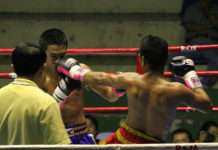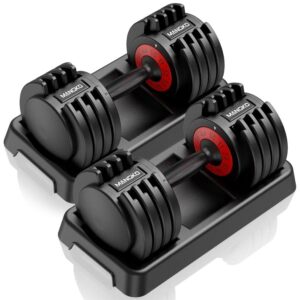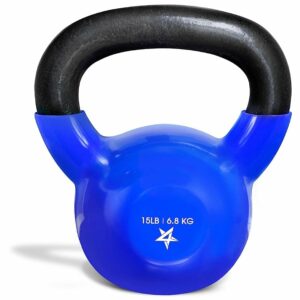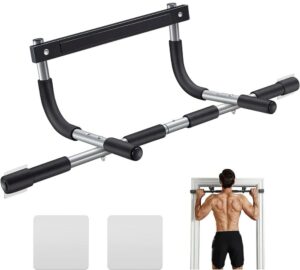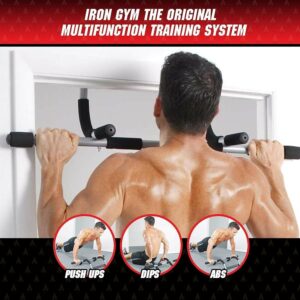Jiu Jitsu can build muscle, but it is not the most effective form of exercise for serious muscle building. While Jiu Jitsu does not provide the right stimulus for massive muscle growth, there are certain situations where you can build muscle through BJJ training
In this article, I dive in to the following areas with regards to whether Jiu Jitsu build muscle:
- How can Jiu Jitsu build muscle
- Why BJJ is not the most effective method for muscle growth
- Benefits of BJJ for muscle building
- How to combine BJJ with muscle building
- Mistakes of BJJ for muscle building
- How quickly can you build muscle with Jiu Jitsu?
By the time you finish reading, you will have a complete answer to the question: does Jiu jitsu build muscle?
Table of Contents
How does Jiu Jitsu build muscle?

BJJ works many muscles in the body, and you may build muscle in BJJ during your early days of training, especially if you have not done Jiu Jitsu muscle building routines in the past.
Muscle building requires intense stimulus to the specific muscles you want to build. As such, if you train BJJ at an intense level, it can provide stimulus to the muscles that results in an enlargement of the fibers.
Beginning BJJ practitioners can increase the size of various muscle groups through Jiu jitsu training. This results in developing muscular fibers and some increase in muscle mass. However, you will quickly plateau your in muscle gains if your only form of exercise is BJJ.
What types of muscle does Jiu Jitsu build?
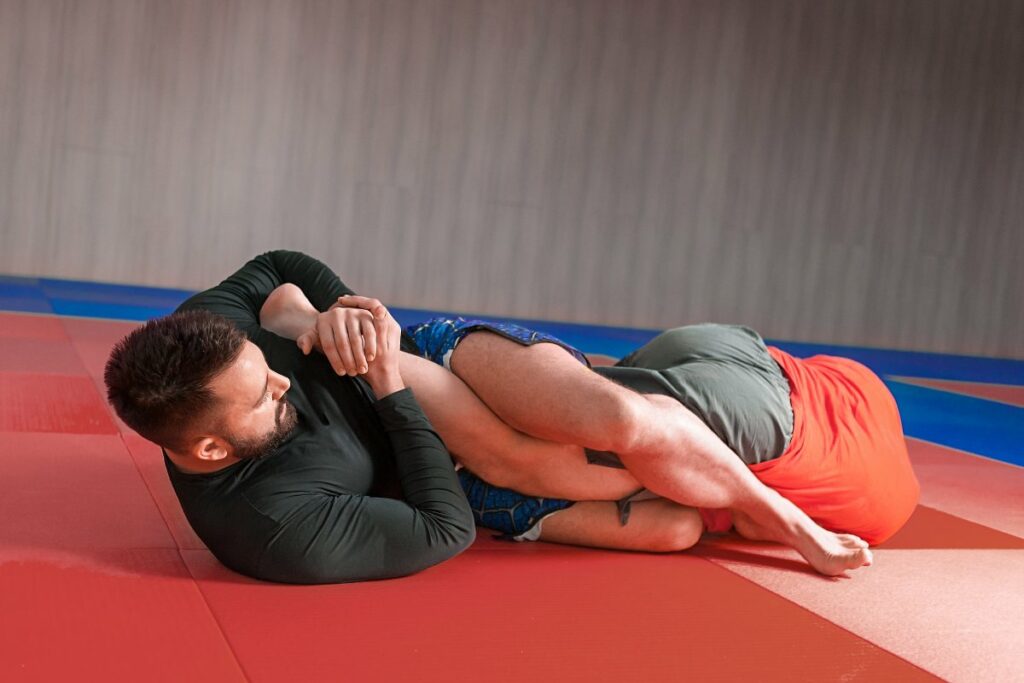
In the long run, Jiu Jitsu is a combination of fast-pace, explosive activity combined with slower endurance training and conditioning. This results in the use of various muscle fiber types, which to simplify things, are typically categorized as either “Type I fibers” (endurance), and “Type II” fibers (muscle strength/power).
Between the two types of muscle fiber, Type II fibers have the greater potential for muscle hypertrophy.
Your BJJ game style will play a major role in which muscle types you trigger. If your game relies on slower paced endurance, then Type I fibers will be the main focus. If your game involves a high intensity level, then you will favor Type II fibers.
Muscles targeted in Jiu Jitsu

From Jiu-Jitsu guard to passing, wrestling scrambles, and other techniques, the sport of Brazilian Jiu Jitsu requires lots of hips, core, legs, and some torso strength. You also use a fair bit of grip and strength in the hands, especially if you train Jiu Jitsu in the Gi. The muscles in these areas include the quads, glutes, hamstrings, shoulders, arms, lats and back.
Note that while these muscles are used, in many cases strength and endurance developments are favored, but muscle building is less emphasized in BJJ training.
Why Jiu Jitsu is not the best way to build muscle
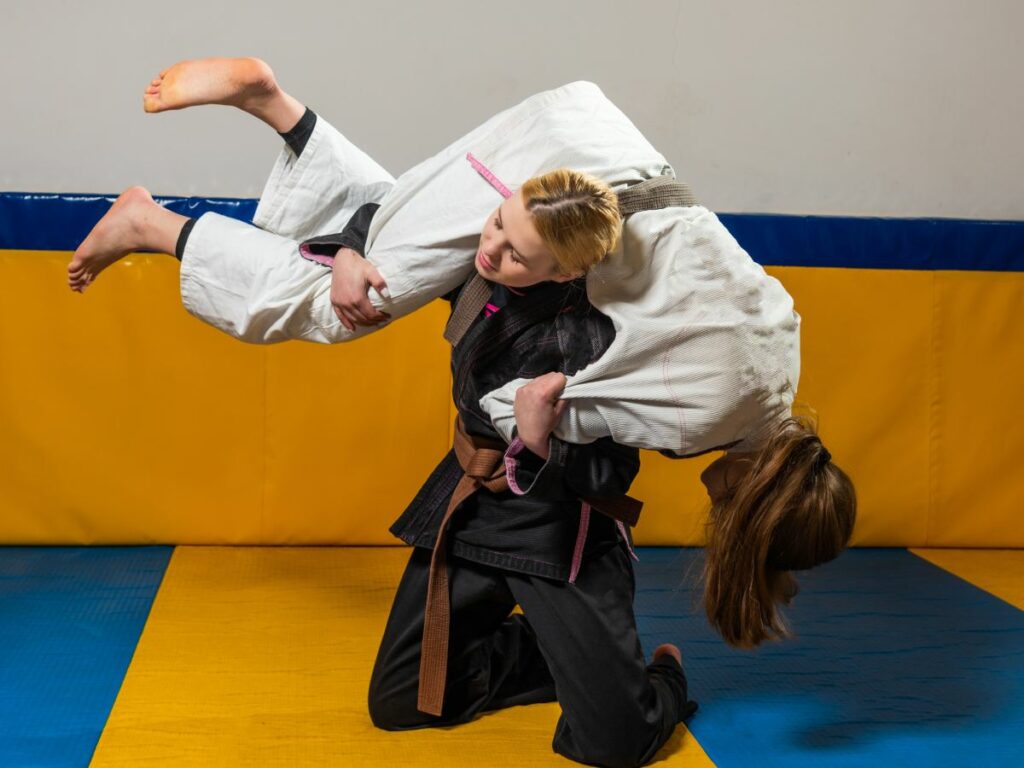
Despite BJJ’s small potential to build muscle, if your goal is serious muscle growth whether for a bodybuilder physique or athletic performance, you will need to lift weights for BJJ or perform some other form of heavy resistance training.
Effective hypertrophy workouts require mechanical tension, such as through the use of barbell training, dumbbell training, and other forms of resistance training such as body weight or kettlebells for BJJ.
If your goal is to compete in bodybuilding or build impressive muscles, you will need to include weight training in your routine one way or another.
This will also give you the benefit of increased strength for BJJ, which can help with defeating your opponent in competition, strengthening your whole body, applying more pressure in submissions, and assisting in other fitness goals like BJJ weight loss and fat burning. In some cases, weight lifting can also help your cardio.
Are there benefits of Jiu Jitsu for muscle building?
Despite the fact that BJJ is not an ideal workout for muscle building, training Jiu Jitsu can play a role in your overall muscle building program.
The conditioning you get from BJJ and intense workout can compliment your muscle building program by helping you with endurance, which can allow you to do more intense training in the gym.
Additionally, the BJJ classes and overall lifestyle assist in fat burning and hitting an energy deficit for weight loss, which can help you reveal your hard earned muscle gains, especially if your goal is to get six-pack abs. It also helps improve your overall health and fitness, which is important for longevity. Overall, the Brazilian Jiu-Jitsu lifestyle can improve your accountability, give your workouts in the gym a stronger purpose, and help deliver the results you want out of your fitness program.
Tips for building muscle while training Jiu Jitsu
If you are training Jiujitsu and also aiming to gain muscle, the following are some top tips to get the most out of your program:
Separate your weight training and Jiu Jitsu training

To build the most amount of muscle, you want to dedicate serious energy to your weight training routine. As such, it’s important that you are fresh for your weight training exercises. The number of athletes who attempt to train in the weight room immediately after doing Jiu Jitsu is very high, and this diminishes your muscle gains.
As such, separate your BJJ and weight training by multiple hours. If your primary goal is muscle building, perform your weight training earlier in the day, then eat a high protein meal with some carbohydrates and get some rest and recovery before going to Brazilian Jiu Jitsu class.
Moderate your intensity on the mats
Muscle growth happens in between your weight training sessions as a result of proper nutrition and recovery. As such, if you are aiming to build muscle, you should focus on training your BJJ techniques as a lower intensity to ensure you do not burn yourself out and fail to recover from your weight training.
There is a reason bodybuilders don’t train Jiu-Jitsu as maximal intensity when they are in a bulking phase. They need the recovery to ensure there muscle fibers grow effectively.
As such, take advantage of your muscle building time to focus on improving your BJJ technique. There is a lot of BJJ drilling benefits you can get without ramping up the intensity. Focus on the fundamental movement and technique skills in jiujitsu. Consider watching instructional videos to supplement your mat hours without adding an additional recovery demand.
Eat a proper diet and get the right nutrition for muscle building

Building muscle requires you to eat enough calories and the right foods to recover and grow your muscle. This means getting a healthy combination of carbs, protein, and fats to ensure muscle protein synthesis. For optimal muscle growth, you will need a calorie surplus of around 300 calories.
Individuals who want to burn body fat should generally seperate fat burning phases from muscle growth phases, and can put more emphasis on intense BJJ training when burning fat.
Include flexibility and mobility training for BJJ
Although flexibility training does not directly boost your BJJ muscle growth, it’s still an important part of making sure you stay healthy, and can assist in injury prevention. Like many martial arts and combat sports or self-defense systems, BJJ training is very hard on your individual joints. To avoid adding to the stiffness, be sure to lift weights with a full range of motion and include stretching for BJJ as part of your overall grappling fitness.
Include strength training phases
Muscle building for BJJ usually focuses on repetition ranges in the 6 to 12 rep range. While you will build some strength using this rep range, the focus will be more on muscle hypertrophy.
It’s very beneficial to cycle through weight training phases where you incorporate lower, heavy repetition sessions in your routine. Fighters need stamina and strength alike to be effective, and BJJ is no exception.
Grip strength, lower body strength, core strength, and upper body strength are all important aspects of being a well-rounded athlete. Everyone from men and women alike will benefit from incorporating strength phases into their routines.
Consider activities like powerlifting, strongman, Olympic lifting, and even CrossFit if you want to supplement your BJJ with another sport. These sports all have a strength and muscle building component to them.
Hire a personal trainer for your BJJ muscle building program
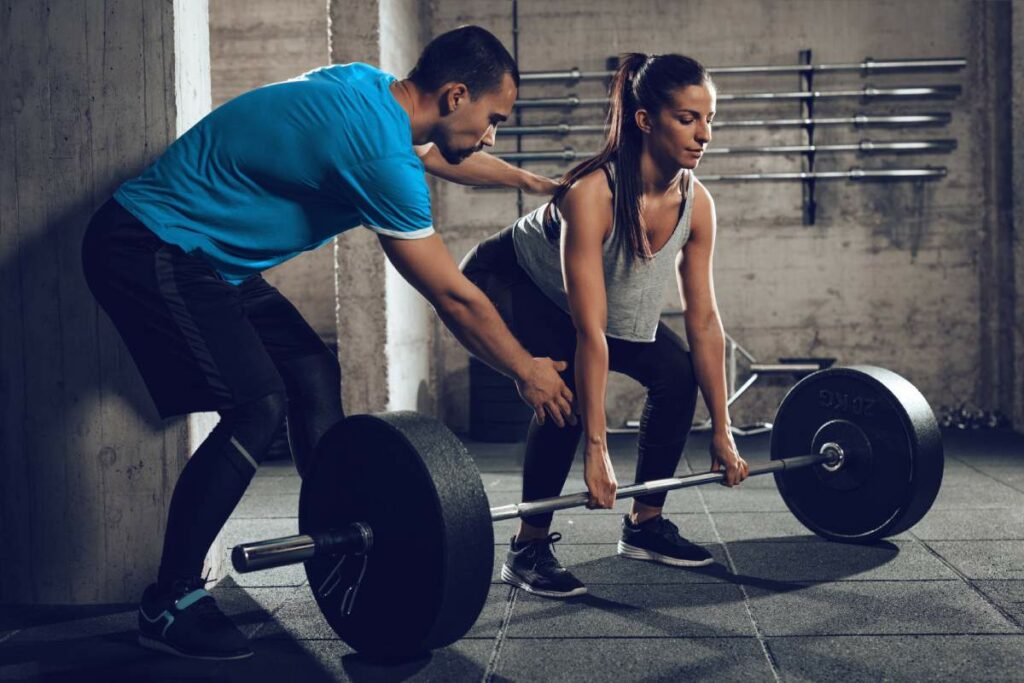
If you can afford it, hiring a personal trainer can be a great way to get the best muscle building routine for BJJ and make the fastest progress. Try to find a trainer who has experience with both BJJ and personal training. This ensures they can design the right workout program to meet your needs as a BJJ athlete.
Home workout equipment for BJJ muscle building
The following are a few of the top pieces of workout equipment you might consider if you are going to do an at-home BJJ workout.
Barbell
A barbell is a versatile piece strength training equipment consisting of a long metal bar with weights attached to either end. This tool offers a wide range of exercises, such as squats, deadlifts, and bench presses, allowing individuals to target various muscle groups effectively. Its adjustable weight load and compound movement capabilities make the barbell an essential choice for building muscle, enhancing strength, and promoting overall fitness.
Here are two of the best barbell you can order on amazon:
Signature Fitness Cast Olympic Barbell
XMark Olympic Weight Set
Dumbbells
Dumbbells are versatile fitness equipment consisting of two weighted ends connected by a handle, designed to enhance strength training and overall fitness. Their adjustable weight options and compact design make them ideal for various exercises targeting different muscle groups, promoting muscle growth, improving bone health, and enhancing overall functional strength. Dumbbells offer a flexible and accessible way to tailor workouts to individual fitness levels and goals, making them a fundamental tool for both beginners and experienced athletes.
Here are two of the best dumbbells you can order on amazon:
Adjustable Dumbbell 55LB
Northdeer Steal Dumbbells Ultracompact & Adjustable Chrome Dumbbell
Kettlebell
A kettlebell is a versatile fitness equipment resembling a cannonball with a handle, designed for dynamic and functional workouts. Its unique shape allows for a wide range of movements, including swings, snatches, and squats, engaging multiple muscle groups and promoting strength, endurance, and flexibility. Kettlebells offer an efficient way to improve cardiovascular fitness, build strength, and enhance overall body coordination in a compact and space-efficient manner.
Here are two of the best kettlebell you can order on amazon:
Yes4All Kettlebell
BalanceFrom Wide Grip Kettlebell
Resistance bands
Resistance bands are flexible and stretchable tools utilized in workouts to add resistance to various exercises. Their adaptable nature allows for a wide range of strength training and muscle activation routines, making them suitable for both beginners and advanced fitness enthusiasts. These bands promote functional strength, enhance coordination, and assist in injury prevention, all while being easily storable and convenient for home or travel workouts.
Here are two of the best resistance bands you can order on amazon:
Resistance Band Set for Men and Women
Whatafit Resistance Bands Set
Pull up bar
A pull-up bar is a simple yet effective piece of exercise equipment designed to be mounted on a doorframe, wall, or ceiling. It allows individuals to perform various upper body exercises, primarily pull-ups and chin-ups, which target the back, shoulders, and arms. Incorporating a pull-up bar into a fitness routine promotes muscle strength, improves posture, and offers a convenient way to engage multiple muscle groups for a well-rounded workout at home.
Here are two of the best pull up bars you can order on amazon:
Ally Peaks Pull Up Bar
Iron Gym Pull-Up Bar
Best exercises for BJJ muscle building
The following are some of the best exercises you can use to build muscle for BJJ. You can use a variety of workout equipment or even bodyweight movements. Combine 3-4 lower body exercises with 3-4 upper body exercises, split across 2-3 different workout days. Add 1-2 core exercises and 1-2 arm exercises to each workout as well if you have time.
You can use the core, biceps, and triceps arm exercises for finishers.
Complete 6-12 repetitions of each exercises using a weight that allows 1-2 “reps in reserve” by the end of the set. For example, if performing 8 repetitions, you might have one in the tank after repetition number 8, especially on the first set.
Aim for 3-4 working sets per exercise and rest for 1-2 minutes between sets
Leg exercises
Squats

Barbell Squats
To perform barbell squats:
- Start by setting up a barbell on a squat rack at chest height. Stand facing the bar, feet shoulder-width apart. Duck under the bar so it rests on your upper back/traps, gripping the bar wider than shoulder-width apart.
- Lift the bar off the squat rack and step back to clear the hooks. Set your feet shoulder-width apart with toes slightly outward. Engage your core and keep your chest up.
- Begin the squat by pushing your hips back and bending your knees. As you descend, ensure your knees stay in line with your toes and your spine remains neutral. Go as deep as comfortable, ideally until your thighs are parallel with the ground or slightly below. Push through your full foot to rise back to the starting position.
- Repeat for target repetitions.
Muscles worked:
- Quadriceps
- Hamstrings
- Glutes
- Lower back (erector spinae)
- Core (rectus abdominis, obliques)
- Upper back (trapezius, rhomboids)
Dumbbell Squats
To perform dumbbell squats:
- Start by standing upright with a dumbbell in each hand, held by your sides. Ensure your feet are shoulder-width apart and your toes are pointing slightly outward.
- Begin the squat by pushing your hips back and bending your knees. Maintain a neutral spine and keep your chest lifted as you descend, ensuring your knees are in line with your toes. Go as deep as comfortable, ideally until your thighs are parallel with the ground or slightly below.
- Push through your full foot to return to the starting position.
- Repeat for target repetitions.
Muscles worked:
- Quadriceps
- Hamstrings
- Glutes
- Lower back (erector spinae)
- Core (rectus abdominis, obliques)
Bodyweight Squats
To perform bodyweight squats:
- Begin by standing upright with your feet shoulder-width apart, toes pointing slightly outward. Place your arms straight out in front of you or hands on your hips.
- Start the squat by pushing your hips back and bending your knees. As you descend, keep your knees in line with your toes, chest lifted, and spine neutral. Descend until your thighs are parallel with the ground or slightly below.
- Push through your full foot to return to the starting position.
- Repeat for target repetitions.
Muscles worked:
- Quadriceps
- Hamstrings
- Glutes
- Core (rectus abdominis, obliques)
Deadlifts

Barbell Deadlifts
To perform a barbell deadlift:
- Stand with your feet hip-width apart, toes pointing straight or slightly outward. Position the barbell so that it’s over the mid-foot. Bend at the hips and knees, keeping your chest up, and grasp the barbell with an overhand or mixed grip (one hand overhand, one hand underhand).
- Push through the full foot, extending your knees and hips simultaneously, lifting the barbell off the ground. Maintain a neutral spine and keep the bar close to your body throughout the movement. Fully extend at the top.
- Slowly lower the barbell back to the ground by hinging at the hips and slightly bending the knees.
- Repeat for target repetitions.
Muscles Worked:
- Glutes
- Hamstrings
- Lower back (Erector Spinae)
- Quadriceps
- Upper back (Trapezius and Rhomboids)
- Forearms
Dumbbell Deadlifts
To perform a dumbbell deadlift:
- Stand with your feet hip-width apart, holding a dumbbell in each hand in front of you with palms facing your thighs.
- Hinge at your hips and bend your knees slightly, lowering the dumbbells along your shins. Keep your back straight and chest lifted. Push through the full foot to return to a standing position, extending your hips and squeezing your glutes at the top.
- Repeat for target repetitions.
Muscles Worked:
- Glutes
- Hamstrings
- Lower back (Erector Spinae)
- Upper back (Trapezius and Rhomboids)
- Forearms
Bodyweight Deadlifts (Hip Hinge)
To perform a bodyweight deadlift (hip hinge):
- Starting Position: Stand with your feet hip-width apart and place your hands on your hips or let them hang in front of you.
- Movement: Hinge at the hips, pushing your glutes back while maintaining a straight back. Your knees should have a slight bend. Go as far as you can without rounding your back.
- Finish: Push through the full foot to return to the standing position, squeezing the glutes at the top.
- Repeat for target repetitions.
Muscles Worked:
- Glutes
- Hamstrings
- Lower back (Erector Spinae)
Hip thrusts
Hip Thrusts Using Dumbbells
To perform a hip thrusts using dumbbells:
- Start by sitting on the ground with a bench or stable platform behind you. Hold a dumbbell across your hips, positioning it so the weight is evenly distributed over your hip region.
- Lean back against the bench, ensuring your shoulder blades are resting near the top of it. Keep your feet flat on the ground, positioned shoulder-width apart. This is your starting position.
- Engage your core and squeeze your glutes as you push through the full foot to lift your hips towards the ceiling, keeping the dumbbell stable on your hips. Ensure your body forms a straight line from shoulders to knees at the top of the movement. Slowly lower your hips back down to the starting position.
- Repeat for target repetitions.
Muscles Worked:
- Gluteus Maximus
- Hamstrings
- Quadriceps
- Core muscles (for stability)
Hip Thrusts Using Barbell
To perform a hip thrusts using a barbell:
- Begin by positioning the barbell over your hips while sitting on the ground with a bench or stable platform behind you. You might want to use a pad or folded mat under the barbell for added comfort.
- Lean back against the bench, ensuring your shoulder blades are resting near the top of it. Position your feet flat on the ground, shoulder-width apart. This is your starting position.
- Engage your core and squeeze your glutes, then push through the full foot to lift your hips towards the ceiling, ensuring the barbell remains stable on your hips. At the top, your body should form a straight line from shoulders to knees. Slowly lower your hips back to the starting position.
- Repeat for target repetitions.
Muscles Worked:
- Gluteus Maximus
- Hamstrings
- Quadriceps
- Core muscles (for stability)
- Technique:
Hip Thrusts Using Bodyweight
To perform a hip thrusts using bodyweight:
- Start by sitting on the ground with a bench or stable platform behind you. No additional weights are required.
- Lean back against the bench, making sure your shoulder blades are resting near the top of it. Place your feet flat on the ground, shoulder-width apart. This is your starting position.
- Engage your core and squeeze your glutes, then push through the full foot to elevate your hips towards the ceiling. At the peak of the motion, your body should form a straight line from shoulders to knees. Gently lower your hips back to the starting position.
- Repeat for target repetitions.
Muscles Worked:
- Gluteus Maximus
- Hamstrings
- Quadriceps
- Core muscles (for stability)
Lunges
Lunges with Dumbbells
To perform a hip lunges using dumbbells:
- Begin by holding a dumbbell in each hand at your sides, palms facing inwards, and stand tall with your feet hip-width apart.
- Step forward with one foot, while rotating your trailing foot inward slightly. As you descend, lower your back knee towards the ground, ensuring your front knee doesn’t extend past your toes. Maintain a straight posture and keep your core engaged.
- Push through your full foot of the leading leg to return to the starting position.
- Repeat for target repetitions and then switch legs.
Muscles Worked:
- Quadriceps
- Hamstrings
- Glutes
- Core
- Calves
Lunges with Barbell
To perform a hip lunges using a barbell:
- Start by positioning a barbell at shoulder level on a squat rack. If available, set the safety pins just above waist level. Position the barbell on your upper back and shoulders, gripping the barbell wider than shoulder-width apart.
- With the barbell securely placed on your upper back, step forward with one foot, rotating your trailing foot inward slightly. Descend by lowering your back knee towards the ground, ensuring your front knee remains aligned and doesn’t pass your toes. Keep your chest up and engage your core.
- Push through your full foot of the front leg to return to the starting position.
- Repeat for target repetitions, then switch legs.
Muscles Worked:
- Quadriceps
- Hamstrings
- Glutes
- Core
- Upper back (for stability)
Bodyweight Lunges
To perform a hip lunges using bodyweight:
- Begin by standing tall with your feet hip-width apart and hands on your hips.
- Take a step forward with one leg, rotating your trailing foot inward slightly. Lower your back knee towards the ground, ensuring your front knee doesn’t go beyond your toes. Stay upright and keep your core tight.
- Push through your full foot of the leading leg to return to the starting position.
- Repeat for target repetitions and then switch legs.
Muscles Worked:
- Quadriceps
- Hamstrings
- Glutes
- Core
Pushing exercises
Bench press
Bench Press Using Dumbbells
To perform a dumbbell bench press:
- Lie down on a flat bench with a dumbbell in each hand, palms facing forward. Start with the weights just above your shoulders, elbows bent at a 90-degree angle.
- Exhale and press the dumbbells upwards until your arms are fully extended above your chest. Visualize squeezing a piece of fruit in your armpit as you press up, ensuring you avoid shrugging throughout the range of motion.
- Inhale as you slowly lower the dumbbells back to the starting position above your shoulders. Squeeze the end range for about 1 second.
- Repeat for target repetitions.
Muscles Worked:
- Pectoralis Major
- Pectoralis Minor
- Triceps Brachii
- Anterior Deltoids
- Serratus Anterior
Bench Press Using Barbell
To perform a barbell bench press:
- Lie down on a flat bench underneath a squat rack. Position a barbell at shoulder level on the squat rack. If available, set the safety pins just above waist level. With palms facing forward, grasp the bar slightly wider than shoulder-width.
- Unrack the bar and hold it above your chest with arms fully extended. This is your starting position.
- Inhale as you lower the bar to your chest, ensuring you avoid shrugging throughout the range of motion. Visualize crushing a piece of fruit in your armpit.
- Exhale as you press the bar back up to the starting position. Squeeze the end range for about 1 second.
- Repeat for target repetitions.
Muscles Worked:
- Pectoralis Major
- Pectoralis Minor
- Triceps Brachii
- Anterior Deltoids
- Serratus Anterior
Shoulder press
Dumbbell Shoulder Press:
To perform a dumbbell shoulder press:
- Sit on a bench with back support, holding a dumbbell in each hand at shoulder height. Elbows should be bent and palms facing forward.
- Extend your arms and press the dumbbells upwards until your arms are fully extended, ensuring you do not lock your elbows. Visualize reaching for the ceiling without shrugging your shoulders.
- Slowly lower the dumbbells back to the starting position at shoulder height.
- Repeat for target repetitions.
Muscles Worked:
- Deltoids (anterior, medial, posterior)
- Triceps
- upper traps
Barbell Shoulder Press:
To perform a barbell shoulder press:
- Position a barbell at shoulder level on a squat rack. Grasp the barbell slightly wider than shoulder width, with palms facing forward. Lift the bar off the rack and position it at shoulder height.
- Extend your arms to press the barbell upwards, ensuring you do not lock your elbows. As you press, avoid shrugging throughout the range of motion.
- Slowly lower the barbell to the starting position at shoulder height.
- Repeat for target repetitions.
Muscles Worked:
- Deltoids (anterior, medial, posterior)
- triceps
- upper traps
Bodyweight Pike Push-up (shoulder press variation):
To perform a bodyweight pike push-up:
- Begin in a high plank position (similar to a push-up position). Lift your hips towards the ceiling, creating an inverted “V” shape with your body.
- Bend your elbows and lower your head towards the ground, keeping your hips high. Ensure you avoid shrugging your shoulders throughout the range of motion.
- Press through your hands, extending your arms, and returning to the inverted “V” position.
- Repeat for target repetitions.
Muscles Worked:
- Deltoids (anterior, medial)
- triceps
- upper traps
Push ups
To perform a bodyweight push up:
- Begin in a plank position with your hands placed shoulder-width apart on the ground and your feet together.
- Tighten your core and maintain a straight line from head to heels. Avoid shrugging your shoulders throughout the range of motion.
- Lower your body by bending your elbows, keeping them close to your sides. Push through your hands to extend your arms and return to the starting position. Squeeze your chest at the end range for about 1 second.
- Repeat for target repetitions.
Muscles Worked:
- Chest (Pectorals)
- Shoulders (Deltoids)
- Triceps
- Core (Rectus Abdominis and Obliques)
Pec fly
To perform a pec fly using dumbbells:
- Lie flat on a bench, holding a dumbbell in each hand with arms extended above your chest. Palms should face each other and elbows slightly bent.
- Slowly open your arms out to the sides, maintaining the slight bend in your elbows and ensuring they remain at shoulder height. Go down until you feel a stretch in your chest muscles.
- Bring the dumbbells back together above your chest by squeezing your pectoral muscles together. At the end range of motion, squeeze the muscles for about 1 second.
- Repeat for target repetitions.
Muscles worked:
- Pectoralis major
- pectoralis minor
- deltoids
- biceps (as stabilizers)
Pulling exercises
Pull ups
To perform a pull up using just your bodyweight:
- Begin by gripping a pull-up bar with an overhand grip (palms facing away from you) slightly wider than shoulder-width apart.
- Hang with your arms fully extended and feet off the ground. Ensure your shoulders are relaxed and not shrugged.
- Pull yourself up by drawing your elbows down, retracting your shoulder blades, and visualizing crushing a piece of fruit in your armpit as you lift. Your chin should go above the bar at the top of the motion. Squeeze at the end range of motion for about 1 second.
- Slowly lower yourself down to the starting position.
- Repeat for target repetitions.
Muscles worked:
- Latissimus dorsi
- biceps brachii
- brachialis
- rhomboids
- trapezius
- core muscles
Barbell rows
To perform a barbell rows:
- Stand with feet hip-width apart, gripping the barbell with an overhand grip slightly wider than shoulder-width.
- Hinge at the hips, pushing your butt back, and slightly bend your knees. Lower your torso until it’s at a 45-degree angle to the ground. Keep your back straight and neck in a neutral position.
- Pull the barbell towards your lower ribcage, visualizing crushing a piece of fruit in your armpit while retracting your shoulder blades. Squeeze at the end range for about 1 second. Avoid shrugging your shoulders during the movement. Return the barbell to the starting position.
- Repeat for target repetitions.
Muscles worked:
- Lats (Latissimus Dorsi)
- Rhomboids
- Middle and lower trapezius
- Biceps
- Erector Spinae
Barbell Rows using Bodyweight (Inverted Row)
To perform a barbell rows using bodyweight:
- Position yourself beneath a bar (such as a Smith machine or TRX straps). Lie on your back and grab the bar with an overhand grip, hands wider than shoulder-width apart. Extend your legs straight out in front of you with heels on the ground.
- Start with arms fully extended and body in a straight line from head to heels. Engage your core.
- Pull yourself upwards towards the bar, visualizing crushing a piece of fruit in your armpit as you retract your shoulder blades. Squeeze at the end range for about 1 second. Make sure to avoid shrugging your shoulders during the entire motion. Slowly lower yourself back to the starting position.
- Repeat for target repetitions.
Muscles worked:
- Lats (Latissimus Dorsi)
- Rhomboids
- Middle and lower trapezius
- Biceps
- Core muscles
Dumbbell row
To perform a dumbbell row using dumbbells:
- Stand with feet hip-width apart and hold a dumbbell in each hand with palms facing each other.
- Hinge forward at the hips, keeping a slight bend in the knees, until your torso is almost parallel to the ground. Keep your back straight and core engaged.
- With a neutral grip, pull the dumbbells up towards your sides, visualizing crushing a piece of fruit in your armpit as you retract your shoulder blades and squeeze at the end range of motion. Avoid shrugging throughout the range of motion. Lower the dumbbells back down to the starting position.
- Repeat for target repetitions.
Muscles Worked:
- Latissimus dorsi
- Rhomboids
- Middle and lower trapezius
- Biceps
- Brachialis
Reverse flies
Reverse flies using dumbbells
To perform reverse flies using dumbbells:
- Stand with feet shoulder-width apart, holding a dumbbell in each hand with a neutral grip. Hinge forward at the waist until your torso is almost parallel to the ground, arms extended below your chest with palms facing each other.
- Keeping a slight bend in your elbows, raise the dumbbells out to the sides, squeezing your shoulder blades together and visualizing crushing a piece of fruit in your armpits. Avoid shrugging throughout the range of motion and hold at the peak contraction for about 1 second.
- Slowly lower the dumbbells back to the starting position.
- Repeat for target repetitions.
Muscles worked:
- Rear deltoids
- rhomboids
- middle and lower trapezius
Core exercises
Hanging leg raise
To perform a hanging leg raise using bodyweight:
- Hang from a pull-up bar with a grip slightly wider than shoulder-width apart. Ensure your arms are straight and your shoulder blades are engaged. Visualize crushing a piece of fruit in your armpit as you retract your shoulder blades.
- Engaging your core, raise your legs up until they reach parallel to the ground or as high as your flexibility allows.
- Control your descent, lowering your legs slowly back to the starting position.
- Repeat for target repetitions.
Muscles Worked:
- Rectus abdominis
- Obliques
- Hip flexors
Russian twist
Russian Twist with Dumbbells
To perform a russian twist with a dumbbell:
- Sit on the floor with your legs extended in front of you. Hold a dumbbell with both hands, arms extended out in front of your chest.
- Lean back slightly, engaging your core, and lift your feet a few inches off the ground to balance on your sit bones. Keep your spine straight.
- Rotate your torso to the left, bringing the dumbbell to the left side of your body. Then, rotate to the right, bringing the dumbbell to the right side. Ensure you’re not merely moving your arms, but using your core to twist your torso. Visualize drawing your lower rib towards your pelvis and engage your abs throughout the movement.
- Repeat for target repetitions.
Muscles worked:
- Rectus abdominis (Abs)
- Obliques
- Transverse abdominis
Bodyweight Russian Twist
To perform a russian twist using bodyweight:
- Sit on the ground with your knees bent and feet flat on the floor. Place your hands together in front of you or clasp them for support.
- Lean back slightly so your upper body is at about a 45-degree angle to the floor. Lift your feet off the ground to balance on your sit bones.
- Rotate your torso to the left, reaching your hands towards the left side of your body, and then rotate to the right, reaching to the right side. Engage your core throughout the movement and visualize drawing your lower rib towards your pelvis.
- Repeat for target repetitions.
Muscles worked:
- Rectus abdominis (Abs)
- Obliques
- Transverse abdominis
V-ups
To perform a v-ups:
- Begin by lying flat on your back on a mat, with your arms extended overhead and your legs straight in front of you.
- In one smooth motion, lift both your legs and upper body off the floor, reaching your hands towards your feet, forming a “V” shape with your body.
- Slowly lower yourself back down to the starting position without letting your arms or legs touch the ground.
- Repeat for target repetitions.
Muscles worked:
- Rectus Abdominis
- Obliques
- Hip Flexors
Arm exercises
Bicep curls
Bicep Curls using Dumbbells
To perform a bicep curls using dumbbells:
- Stand upright with a dumbbell in each hand, arms extended and palms facing forward.
- Keeping your elbows close to your torso, curl the dumbbells upward by contracting the biceps. Squeeze the end range for about 1 second.
- Slowly lower the dumbbells back to the starting position.
- Repeat for target repetitions.
Muscles Worked:
- Biceps brachii
- Brachialis
- Brachioradialis
Bicep Curls using Barbell
To perform a bicep curls using a barbell:
- Position yourself standing upright holding a barbell with both hands shoulder-width apart and palms facing forward.
- Keeping your elbows close to your torso, curl the barbell upward by contracting the biceps. Squeeze the end range for about 1 second.
- Slowly lower the barbell back to the starting position.
- Repeat for target repetitions.
Muscles Worked:
- Biceps brachii
- Brachialis
- Brachioradialis
Tricep extensions
Tricep Extensions Using Dumbbells
To perform a tricep extension using dumbbells:
- Start by standing with feet shoulder-width apart, holding a dumbbell in each hand. Raise the dumbbells overhead, keeping your arms close to your ears.
- Slowly bend your elbows, lowering the dumbbells behind your head until your elbows are at about a 90-degree angle. Ensure your upper arms remain stationary and only your forearms move.
- Extend your arms back to the starting position, squeezing the triceps hard at the end range for about 1 second. Avoid shrugging throughout the range of motion.
- Repeat for target repetitions.
Muscles worked:
- Triceps Brachii
Arnold curls
Arnold Curls Using Dumbbells
To perform arnold curls using dumbbells:
- Stand upright with a dumbbell in each hand, arms fully extended by your sides, and palms facing your body.
- As you curl the weights upward, rotate your wrists so that your palms face you at the peak of the movement. Ensure you squeeze the biceps at the end range for about 1 second.
- Slowly lower the weights back to the starting position while rotating your wrists to return to the original grip.
- Repeat for target repetitions.
Muscles Worked:
- Biceps Brachii
- Brachioradialis
- Brachialis
Skullcrushers
Skullcrushers using Dumbbells
To perform skullcrushers using dumbbells:
- Begin by lying flat on a bench with a dumbbell in each hand. Extend your arms straight above your chest, palms facing each other.
- Slowly bend your elbows to lower the dumbbells towards the sides of your head, keeping your elbows in a fixed position.
- Once the dumbbells are near your head, extend your elbows to raise the dumbbells back to the starting position. Squeeze the end range for about 1 second.
- Repeat for target repetitions.
Muscles worked:
- Triceps brachii
Skullcrushers using Barbell
To perform skullcrushers using a barbell:
- Lie on a bench and position a barbell at arm’s length above your chest. Use an overhand grip that’s about shoulder-width apart.
- Keeping your elbows fixed and tucked in, lower the barbell slowly towards your forehead.
- Once the barbell is just above your forehead, push it back up, extending your elbows fully. Squeeze the end range for about 1 second.
- Repeat for target repetitions.
Muscles worked:
- Triceps brachii
Preacher curls
Preacher Curls Using Dumbbells
To perform preacher curls using dumbbells:
- Start by sitting on a preacher bench with your arms resting on the padding and palms facing up. Hold a dumbbell in each hand with a firm grip.
- With a controlled motion, curl the dumbbells upward while keeping your upper arms stable and pressed against the pad. Squeeze the bicep at the top of the movement for about 1 second.
- Slowly lower the dumbbells back to the starting position without letting your biceps fully relax.
- Repeat for target repetitions.
Muscles worked:
- Biceps Brachii
- Brachialis
Preacher Curls Using Barbell
To perform preacher curls using a barbell:
- Sit on a preacher bench with the barbell resting on the safety hooks. Grip the barbell with both hands shoulder-width apart, palms facing up.
- Lift the barbell off the hooks and let your arms extend fully. With a controlled motion, curl the barbell up while keeping your upper arms pressed against the pad. Squeeze the bicep at the top of the movement for about 1 second.
- Slowly lower the barbell back to the starting position, making sure not to shrug throughout the range of motion.
- Repeat for target repetitions.
Muscles worked:
- Biceps Brachii
- Brachialis
- Brachioradialis
Common mistakes when muscle building with Jiu Jitsu
The following are a few key mistakes you should avoid when building muscle and training Jiu Jitsu.
Ignoring recovery
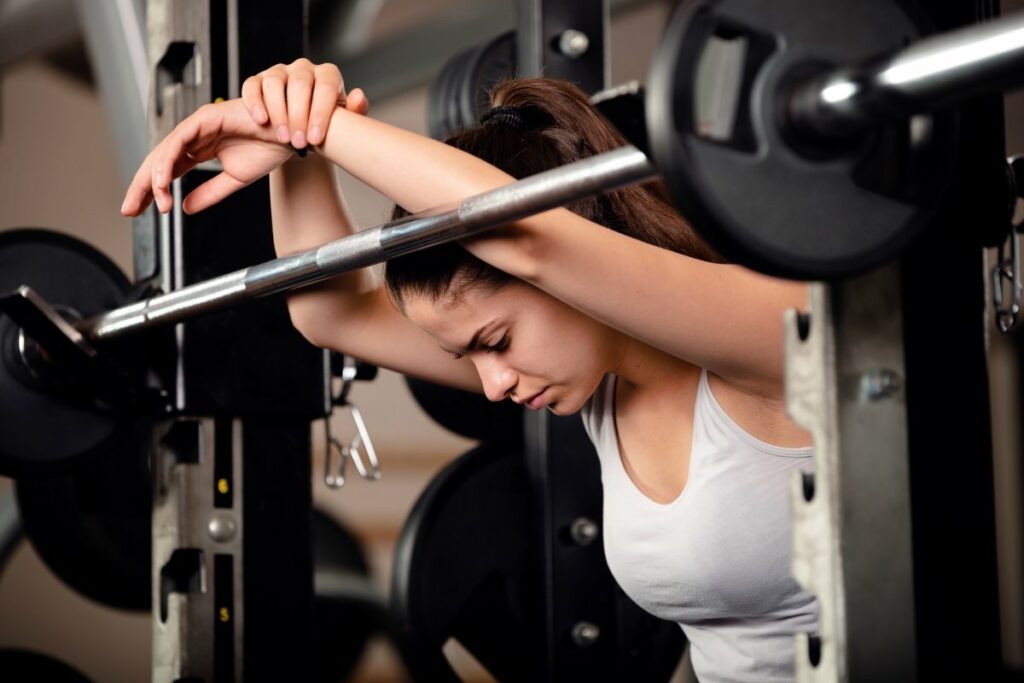
You need to recover properly to build muscle, especially when combining muscle building with BJJ. Be sure to dial back your BJJ intensity when focusing on muscle building. Give yourself at least 2 days off of training per week.
Not managing expectations
If you are training BJJ and doing a muscle building routine, you need to manage your expectations. You are not going to build muscle as quickly as someone who is exclusively focused on lifting weights for hypertrophy. However, you will still be able to build a lot of muscle over time while continuing to improve your BJJ skills.
Focusing on too many goals at once
I recommend focusing on at maximum one fitness goal at a time. A fitness goal could be weight loss, muscle growth, or strength gains. When combining BJJ with muscle building, I recommend you do not attempt to train Jiujitsu as hard as possible, and instead aim to improve your technique. Fat loss and strength0 can be better goals to combine with competition training, but even then, you need to manage expectations and avoid trying to do everything all at once with regards to your overall fitness goals.
Frequently Asked Questions
How long does it take to see results from Jiu Jitsu muscle building?
Muscle building usually takes between 6-12 weeks to begin seeing serious results. If you are new to building muscle, then you might see muscle gains closer to the 4 week mark. Advanced lifters will need extra time to see results.
How does Jiu Jitsu compare to other methods of muscle building?
Brazilian Jiu-Jitsu is not good for building muscle overall. The best way to build muscle is by lifting weights using repetition ranges between 6-12 reps that use a weight heavy enough to be challenging.
How much muscle can you expect to build through Jiu Jitsu?
Not much, unfortunately. Without lifting weights, you are unlikely to build a serious amount of muscle through BJJ training alone.



